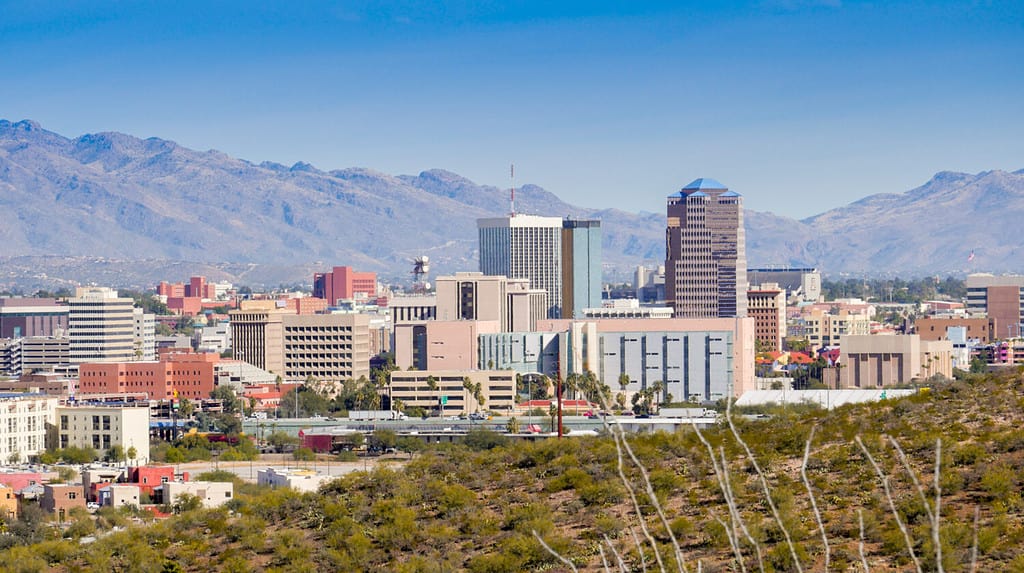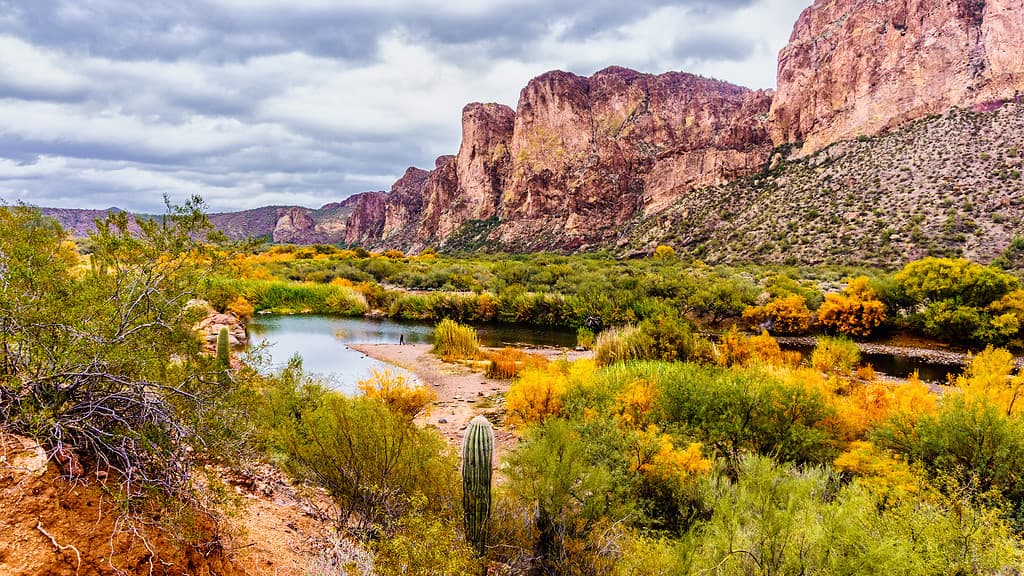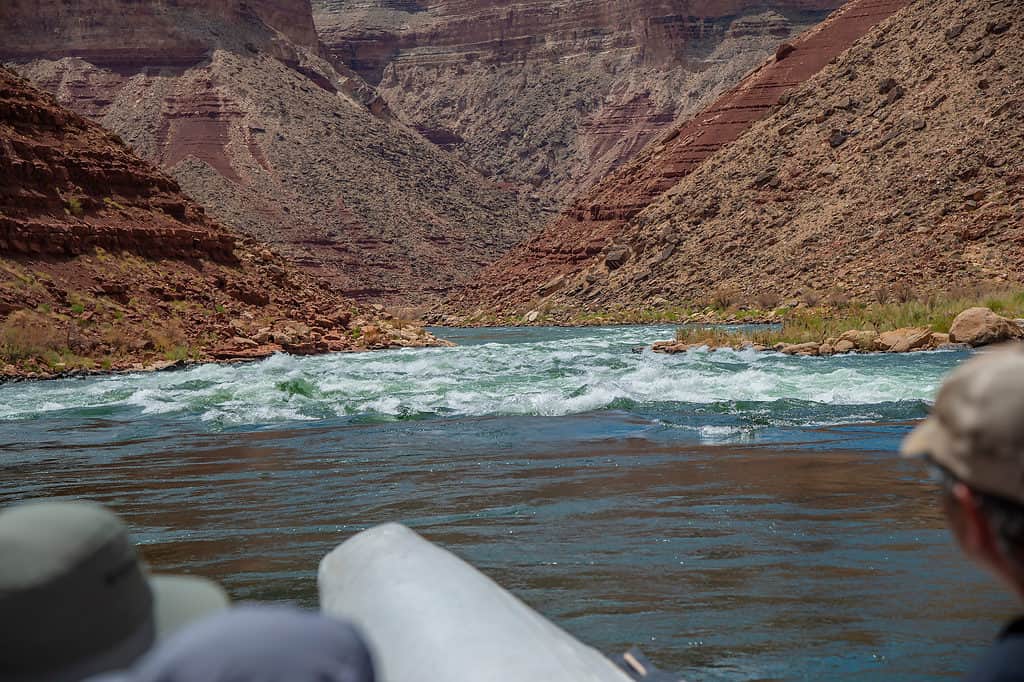Arizona, often celebrated for its striking desert landscapes, is a state that offers far more than what meets the eye. Nestled in the southwestern region of the United States, it’s a land where natural wonders and cultural richness intertwine. From the awe-inspiring Grand Canyon to the vibrant city life of Phoenix and Tucson, Arizona is home to various attractions and experiences. If you’re wondering where Arizona is, we will take a look at where it is on the U.S. map. We’ll also explore Arizona’s bordering states and other facts about The Grand Canyon State.

Arizona is home to a diverse array of attractions and experiences that cater to many.
©Chris Rubino/Shutterstock.com
Where Is Arizona Located on the Map?
Arizona, located in the Southwest United States, is renowned for its expansive deserts, towering mountain ranges, and iconic landmarks like the Grand Canyon.
What States Border Arizona?
Arizona, a state in the Southwest United States, is bordered by four states: California to the west, Nevada to the northwest, Utah to the north, and New Mexico to the east.
California
To Arizona’s west, California, known as the Golden State, stretches along the Pacific Coast. Their shared border is primarily defined by the Colorado River, a crucial water source for both. California, while famed for its coastal cities, tech hubs, and Hollywood glamor, also shares desert landscapes similar to those found in Arizona.
Nevada
Bordering Arizona to the northwest, Nevada, known as the Silver State, is filled with desert basins and mountain ranges. While many know Nevada for the neon lights of Las Vegas, the state’s natural landscapes mirror some of Arizona’s desert beauty.
Utah
To Arizona’s north is Utah, known as the Beehive State. Both states are united by the iconic Monument Valley along their border. Utah, with its national parks and mountainous terrain, is different from Arizona’s desert expanses, showcasing the varied landscapes of the southwest.
New Mexico
To Arizona’s east is New Mexico. Both states share deep roots in Native American and Spanish cultures. New Mexico’s varied landscapes, from its deserts to its rich cultural towns, speak volumes about the beauty and history of the southwest.
When Did Arizona Officially Join the US?

In 1912, Arizona became the 48th state of the U.S.
©turtix/Shutterstock.com
Arizona was admitted as the 48th state of the United States on February 14, 1912. The region, once under Spanish and later Mexican rule, became part of the U.S. after the Treaty of Guadalupe Hidalgo in 1848 and the Gadsden Purchase in 1853. Initially managed as part of the New Mexico Territory, the distinct challenges and identities of the areas led to calls for separate territories. After considerable advocacy and legislative efforts, Arizona was finally recognized as its own state.
What Is the Climate in Arizona?
Arizona’s climate varies from scorching desert lowlands to snowy mountain peaks. This provides distinct weather patterns across Arizona’s diverse regions.
Lowland Desert Areas
- Summer: Hot and dry; temperatures often exceed 100°F.
- Winter: Mild and cool; temperatures range from 60°F to 70°F.
- Precipitation: Sparse, mostly during the monsoon season (July to September).
High Desert Areas
- Summer: Warm with temperatures often in the 80s and 90s°F.
- Winter: Cooler with occasional snow; temperatures can range from 30°F to 50°F.
- Precipitation: Moderate, with slightly more rainfall than the low desert.
Mountainous Regions
- Summer: Mild, with temperatures typically ranging from 70°F to 80°F (21°C to 27°C).
- Winter: Cold and snowy. In places like Flagstaff, temperatures frequently drop below freezing, often plunging into the teens during the coldest months. Heavy snowfall is common, with some areas receiving over 100 inches annually.
- Precipitation: These regions experience more precipitation than the rest of the state, especially during winter, leading to substantial snow accumulations.
Is Arizona a Good Place to Live?

From desert lowlands to snowy mountain peaks, Arizona has various climates.
©Harry Beugelink/Shutterstock.com
Arizona, with its unique blend of natural wonders, diverse climates, and growing urban centers, poses a question for many: is it a good place to live?
Climate Diversity
- Pros: Varied climates to suit preferences, from the warm cities of Phoenix and Tucson to cooler, snow-clad regions like Flagstaff.
- Cons: The desert areas can experience extreme heat during the summer months.
Natural Beauty
- Pros: Features iconic landmarks like the Grand Canyon, Sedona’s red rocks, and the distinct saguaro cacti.
- Cons: The expansive desert might seem exhausting to some.
Cost of Living
- Pros: Arizona has more affordable living compared to coastal states, with many cities offering reasonable housing costs.
- Cons: Certain upscale areas, such as Scottsdale, can have a higher cost of living.
Recreational Activities
- Pros: A plethora of outdoor activities ranging from hiking and mountain biking to skiing in the northern regions.
- Cons: There are limited water-based activities due to the predominantly desert environment.
Cultural and Social Aspects
- Pros: Urban centers with vibrant arts scenes, diverse food options, and a mix of cultural influences. Numerous festivals and events enrich the state’s calendar.
- Cons: Some of the more rural areas may lack the cultural dynamism of the cities.
What Is Arizona Most Known For?

Arizona is a land of contrasts and surprises. Beyond its sun-drenched deserts and iconic cacti, the state boasts a diverse array of cultural, historical, and natural wonders.
©William Eugene Dummitt/Shutterstock.com
Arizona is a land of contrasts and surprises. Beyond its sun-drenched deserts and iconic cacti, the state boasts a diverse array of cultural, historical, and natural wonders.
The Grand Canyon
There is no argument that the Grand Canyon is the most iconic symbol of Arizona. This immense and breathtaking natural wonder has been carved by the Colorado River over millions of years, showcasing a vast panorama of layered rock formations. A UNESCO World Heritage site, it draws millions of visitors from around the globe annually.
Desert Landscapes
The Sonoran Desert, home to the majestic saguaro cactus, is quintessentially Arizonan. These towering cacti, which are unique to the region, stand as silent sentinels against fiery sunsets, symbolizing the state’s rugged beauty.
Historic Route 66
Traversing Arizona, this iconic highway — often termed “The Main Street of America” — passes through charming towns, offering a nostalgic glimpse into America’s automotive past.
The photo featured at the top of this post is © meunierd/Shutterstock.com
Thank you for reading! Have some feedback for us? Contact the AZ Animals editorial team.






